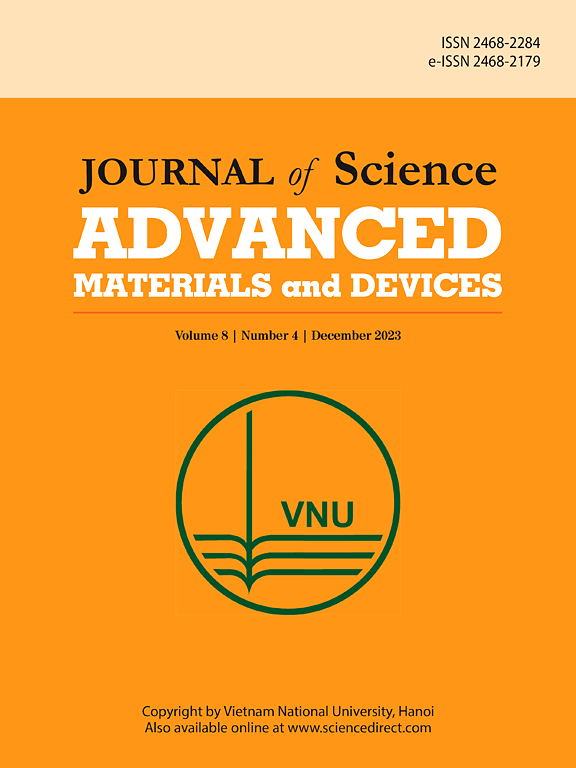Flexible multilayered ceramics: Engineering strength and resilience
IF 6.7
3区 材料科学
Q1 MATERIALS SCIENCE, MULTIDISCIPLINARY
Journal of Science: Advanced Materials and Devices
Pub Date : 2025-03-19
DOI:10.1016/j.jsamd.2025.100874
引用次数: 0
Abstract
While offering exceptional hardness and durability, traditional ceramics are inherently brittle, limiting their use in applications requiring flexibility and impact resistance. This study investigates the mechanical performance of soft, multilayered ceramics, focusing on how hexagonal tile size, adhesive interlayer thickness, and layer configuration influence flexural compliance, penetration resistance, and energy absorption. Using a precision digital laser manufacturing platform, industrial-grade alumina ceramic sheets were laser-cut into 2.5 mm and 5 mm hexagonal tiles, then laminated with adhesive layers to fabricate soft ceramic beams. Experimental results from 4-point bending and penetration tests reveal that smaller tile sizes and thinner adhesive layers enhance flexural compliance, achieving up to a 35 % improvement in flexibility compared to larger tiles and thicker adhesives. Conversely, larger tiles and thicker adhesives improve penetration resistance by up to 28 %, offering superior protection against localized impacts. Configurations featuring larger tiles and thicker adhesive layers also achieved a 42 % increase in energy absorption, demonstrating their ability to store more energy under localized forces. Failure modes varied across configurations, with smaller tiles predominantly exhibiting tilting failure while larger tiles fractured more uniformly under penetration loading. Compared to traditional ceramic armor and bioinspired nacre-like materials, the developed soft ceramics exhibit significantly higher weight-specific compliance while maintaining competitive penetration resistance and energy absorption. This novel integration of laser-cutting, adhesive bonding, and structural optimization enables the development of lightweight, durable, and flexible ceramics for personal protective equipment, aerospace, and automotive applications.

传统陶瓷具有超强的硬度和耐久性,但其本身较脆,限制了其在要求柔韧性和抗冲击性的应用中的使用。本研究调查了软质多层陶瓷的机械性能,重点研究了六边形瓷砖尺寸、粘合剂层间厚度和层配置如何影响挠曲顺应性、抗穿透性和能量吸收。利用精密数字激光制造平台,工业级氧化铝陶瓷片被激光切割成 2.5 毫米和 5 毫米的六边形瓷砖,然后与粘合剂层压,制成软陶瓷梁。四点弯曲和穿透测试的实验结果表明,较小尺寸的瓷砖和较薄的粘合剂层可增强挠曲顺应性,与较大的瓷砖和较厚的粘合剂相比,挠曲顺应性最多可提高 35%。相反,较大的瓷砖和较厚的粘合剂可将抗穿透性提高 28%,从而为局部冲击提供出色的保护。采用较大瓷砖和较厚粘合剂层的配置在能量吸收方面也提高了 42%,这表明它们能够在局部受力情况下储存更多能量。不同配置的失效模式各不相同,较小的瓷砖主要表现为倾斜失效,而较大的瓷砖在穿透负荷下的断裂更为均匀。与传统陶瓷装甲和受生物启发的类珍珠质材料相比,所开发的软陶瓷在保持极具竞争力的抗穿透性和能量吸收能力的同时,还显著提高了特定重量的顺应性。这种将激光切割、粘合剂粘接和结构优化融为一体的新方法,能够为个人防护设备、航空航天和汽车应用开发出轻质、耐用和灵活的陶瓷。
本文章由计算机程序翻译,如有差异,请以英文原文为准。
求助全文
约1分钟内获得全文
求助全文
来源期刊

Journal of Science: Advanced Materials and Devices
Materials Science-Electronic, Optical and Magnetic Materials
CiteScore
11.90
自引率
2.50%
发文量
88
审稿时长
47 days
期刊介绍:
In 1985, the Journal of Science was founded as a platform for publishing national and international research papers across various disciplines, including natural sciences, technology, social sciences, and humanities. Over the years, the journal has experienced remarkable growth in terms of quality, size, and scope. Today, it encompasses a diverse range of publications dedicated to academic research.
Considering the rapid expansion of materials science, we are pleased to introduce the Journal of Science: Advanced Materials and Devices. This new addition to our journal series offers researchers an exciting opportunity to publish their work on all aspects of materials science and technology within the esteemed Journal of Science.
With this development, we aim to revolutionize the way research in materials science is expressed and organized, further strengthening our commitment to promoting outstanding research across various scientific and technological fields.
 求助内容:
求助内容: 应助结果提醒方式:
应助结果提醒方式:


